Inverted Nipple Correction in Korea
“What Is Inverted Nipples Surgery?”
An inverted nipple is when the nipple is retracted into the breast instead of pointing outward. One of the most common concerns among patients with inverted nipples is whether the condition will return after surgery and whether breastfeeding will still be possible. These outcomes largely depend on the severity of nipple inversion and the surgical technique used. At VIP Plastic Surgery, the procedure is carefully selected to balance both functional preservation and long-term aesthetic stability.
It occurs because the fibrous band beneath the nipple continues to pull the nipple, and the tissue supporting the nipple is insufficient. An inverted nipple causes not only an aesthetic problem but may also hinder the ability to breastfeed, leading to breast cancer in severe cases. Both women and men can have inverted nipples.
It is congenital and may recur even after surgery.
The method to correct inverted nipple is to cut the fibrous band and support a stout structure beneath the nipple. The inverted nipple is drawn outward through an incision around the areola and suture in various ways to prevent recurrence.
An inverted nipple is not protruded compared to the surrounding tissues and is flat and dented, whereas ideal nipple points outward in appropriate size and height in Ω shape.
Operation Information
- Surgery Time : ~60 Minutes
- Anesthesia Type : Local Anesthesia
- Hospitalization : None
- Stitch Removal : 7-10 Days
- Recovery Time : 7 Days
Causes of Inverted Nipples
The causes are classified mainly as congenital and acquired, and in
most cases, it is congenital and bilateral. When acquired, it can
occur by wound, an aftereffect of breast cancer or complications after
macromastia surgery.
If due to the congenital cause, a mammary gland is formed in
the ectoderm during the sixth to seventh week of fetal life, this
mammary gland grows in the mesenchymal tissue and forms a lactiferous
duct. During the final stage of fetal life, a nipple is formed by
protuberance due to the proliferation of mesenchymal tissue. When the
lactiferous duct is short due to undergrowth or the proliferation of
mesenchymal tissue, an inverted nipple is formed. Thus, it occurs due
to the decreased amount of connective tissues in the inverted nipple.
Inverted Nipples Surgery Method
The objective of the surgery is to restore normality in function,
shape, sensing and more. However, based on the level of severity, it
may be difficult to meet all the goals. As for the correction, the
short lactiferous duct should be lengthened and the fibrous tissue
(which restricts the protrusion of the nipple) should be cut.
Moreover, the insufficient tissue beneath the nipple should be
supplemented.
Among various areola reduction methods, the most appropriate
method should be opted to minimize scar and effectively reduce the
areola.
The basic principle is to incise a part of nipple skin in
the center and suture it. In the case of a large nipple, the upper
part of the nipple is excised, and the rest remains in an appropriate
size and then sutured. Regardless of the method, scars are
inconspicuous and a satisfactory result can be obtained.
CASE 01 : Lactiferous Duct Preserving Method
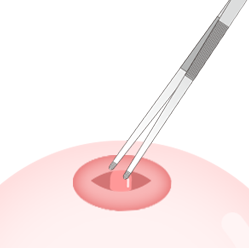
STEP 01 Incise both sides of nipples
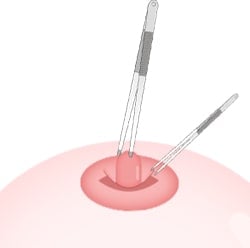
STEP 02 While preserving the nipples, remove the hardened fibrous tissues that pull the nipples downwards.
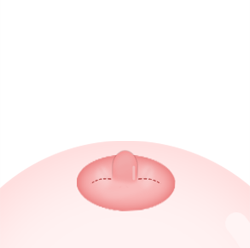
STEP 03 Place the nipples in the center and suture the surrounding tissues.
02 PURSE-STRING SUTURE METHOD
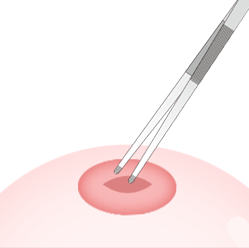
STEP 01 Make an incision around the inverted nipples.
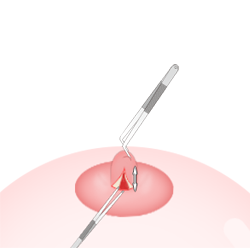
STEP 02 Make an incision in the lactiferous duct and pull out the nipples hidden inside.
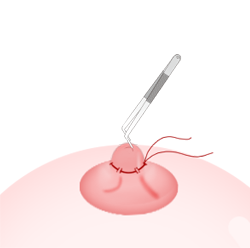
STEP 03 Make a purse-string suture around the nipples.
03 LACTIFEROUS DUCT INCISION METHOD – CANNOT BREASTFEED SURGERY
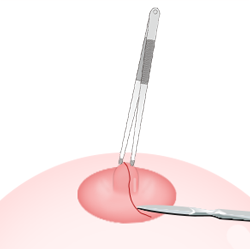
STEP 01 Make an incision in the center of the nipples and find the inverted fibrous and muscular tissues.
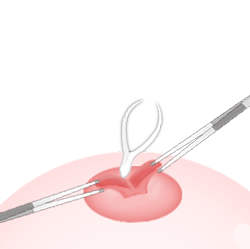
STEP 02 Remove the hardened fibrous and muscular tissues that pull the nipples inverted.
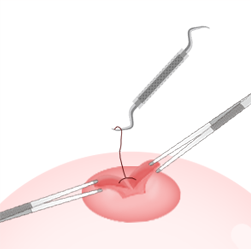
STEP 03 To prevent the further inverted nipples again, improve and create the nipples structure using the surrounding tissues.
Areola Reduction
Nipple hypertrophy is more common in Asians than in Caucasians. It not
only looks aesthetically unpleasant but also causes problems in
breastfeeding.
The symptom occurs generally during pregnancy, childbirth,
and lactation, but may also occur in young women who have unusually
big nipples, requiring a surgery.
For Korean women, the average nipple size is less than 1 cm
in diameter and 7-9 mm in height. The size is not important but should
be in relative size to the shape and size of the breast, forming a
balance. An excessively big nipple breaks the harmonious balance of
the overall breast shape and may appear saggy. Therefore, in such
case, areola reduction is necessary to reshape the nipple in an
appropriate size.

















